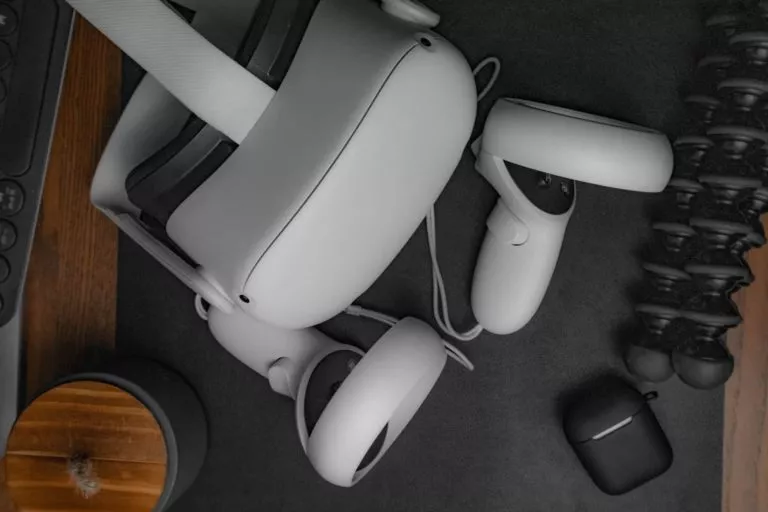
As you may have heard, Meta announced Q4 earnings this week. Among other things, Meta Reality Labs’ (MRL) represented a $5.01 billion expense. There, the message to investors is to stick with Meta while it builds, and cements a central position within, computing’s next era.
This quarter, there was some additional messaging meant to reassure investors. Commitments to some belt-tightening and a $40 billion Zuckerburg stock buyback seemed to do the trick as Meta stock jumped 23 percent. It has sustained around that elevated level as of this writing.
Meanwhile, top-line revenue for MRL (which mostly consists of Quest 2 sales) was $727 million. That’s down 17 percent from $880 million in Q4 2021 (year-over-year). But due to the holiday spending cycle, it’s up 255 percent from $285 million in Q3 2022 (quarter-over-quarter).
There’s a lot to be said about those fluctuations (more on that in a bit). But our main question is how MRL Q4 revenue translates to VR unit sales. Equally meaningful, what’s the total installed base of cumulative Meta VR devices in market? That’s a key health indicator for VR.
Reverse Engineering
Starting with Q4 units sold, what do Meta earnings tell us? This is an exercise we’ve done every quarter for several years, but with a new approach now that Meta breaks out MRL revenue. And things get a bit more complex for Q4 2022 versus Q3 because Quest Pro is in the mix.
Diving in, Reality Labs made $727 million in Q4, as noted. Based on Meta’s disclosures last year, we’ve extrapolated that VR software (game and app sales) is about 23 percent of that. That makes software revenue approximately $167 million*, leaving $560 million for hardware.
As we’ve estimated, headsets are about 92 percent of that, the rest being first-party accessories like head straps and face shields. That brings us to $515 million for headset sales. Again, that’s both Quest and Quest Pro, the former accounting for an estimated 92.7 percent** of revenue.
For Quest 2…
Based on the above, Quest 2’s top-line revenue is $477 million. Considering an average unit price of $429*** this means that Meta sold approximately 1.113 million Quest 2s in Q4.
For Quest Pro…
Based on the above, Quest Pro’s revenue is $38 million. Considering a Q4 unit price of $1,499 (a price drop occurred later in Q1 2023) this means that Meta sold approximately 25,080 Quest Pros in Q4.
Adding up both headsets, we get an estimated total of 1.138 million units sold in Q4.
*This figure represents the Oculus Store’s gross revenue, before developer payouts, which are usually 70 percent after taxes.
**Quest Pro’s portion of revenue is estimated at about 10 percent, further discounted by its October 25th launch date, which makes its time in market 73 percent of Q4. This brings its revenue share to 7.3 percent
***During Q4, Quest 2 base model (128GB) was $399 while the 256GB model was $499. This averages out at $449, but we’ve reduced the estimated hardware ARPU to $429 due to weighted sales for the base model (common for new hardware). Third-party reseller markups aren’t included.
Magic Number
So what does the above mean for Meta’s VR installed base? To estimate, we can go back to the last time we did the above exercise for Q3. At that time, the installed base was 10.3 million units. So with the above 1.138 million, it brings the estimated cumulative total to 11.4 million.
This means that Meta only recently passed the 10-million milestone of in-market VR devices. That has been a key goal for Meta to stimulate VR’s flywheel effect. To be fair, others have estimated that Meta passed this 10-million mark several quarters earlier, but we stand by our projections.
Stepping back, why is 10 million important? According to Mark Zuckerberg, that’s the critical mass to jumpstart an ecosystem. A nine-digit sum attracts developers en masse. Content creation surges then attracts more users, which further attracts developers, and the flywheel spins…
But this milestone is perhaps overshadowed by MRL’s losses. The $5 billion in Q4 expenses is the largest to date. Other bad news comes from a year-over-year revenue decline. Holiday sales declined versus 2021, mostly due to discretionary spending (which VR is) in a downturn.
Passion Project
In terms of MRL expenses, Meta positions it as a necessary investment for the company’s future. This requires two things: One is lots of investor patience (which is running thin). And two is a leadership structure that enables Zuckerberg’s unilateral control. Few companies can do this.
In the process, MRL has been painted in interweb punditry as an ill-timed passion project. But considering declining revenue to its core business, and the existential challenges from Apple’s app tracking transparency (ATT), now is precisely the right time to start building lifeboats.
Moreover, Meta’s investments in VR hardware and operating system make it a bonafide platform. That gives it vertical integration and less dependence on the uncertainties of piggybacking on others’ platforms (read: iOS and Android). Meta has learned this lesson the hard way.
Meanwhile, amidst all the schadenfreude in the tech press, Meta continues to build for the long haul. MRL net losses are projected to widen in 2023, but the more important part is that it’s using today’s dollars to build tomorrow’s business. As always, the proof will be in the execution.

